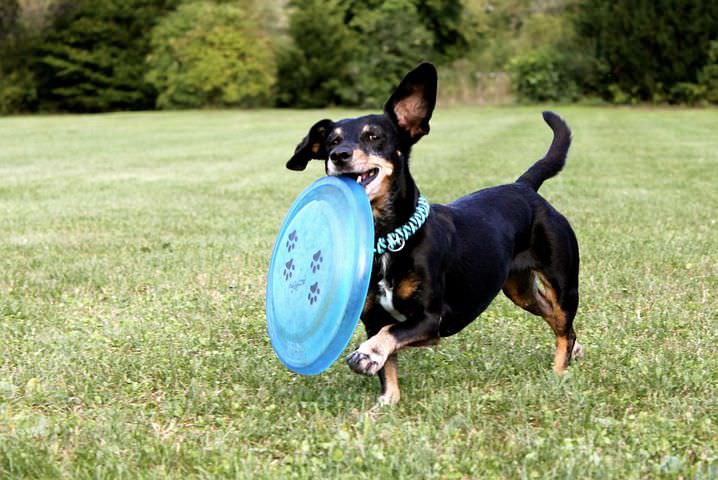It is so hard to watch your dog grow old before your very eyes. It seems like just yesterday, she was a bounding puppy! Now she is just a little stiffer and sleeps more. Wouldn’t you love to know some ways to help her age gracefully?
1. Help your dog get up and down
As nerves and muscles age, certain movements can become difficult. Senior dogs are more likely to suffer from difficulty rising and impaired balance. This means that your dog may benefit from a bed that is slightly raised (but not too high) to make getting up easier and help when navigating slick surfaces. Things that help her have traction on slick surfaces can make a difference, like non-slick mats under her food dishes and in places where you notice her slipping. If she needs to climb steps with you, it can be helpful to sling a towel under her belly for support as you go.
Remember that stiffness and difficulty rising can also be related to certain medical issues. Have your veterinarian help you decide if your dog’s issue is a normal part of aging or can be treated and improved.
2. Address his changing sensory needs
A dog’s senses also change as he ages. The structures of the eye experience age-associated changes, which can decrease their flexibility, leading to difficulty seeing, especially in low-light situations. Visual impairment is an expected process, and some easy changes to your environment can improve your senior dog’s quality of life. A simple change, such as adding night lights to the outlets along dark hallways, might make a big difference for your dog.
Other senses can also be affected by aging. Senior dogs can often lose some or all of their hearing, and their perception of touch can be different. Being tuned in to your dog’s ability to perceive sound and touch can help you modify the way you interact with her. Some owners make a point to stomp their feet when they enter a room so their dog can feel and hear their arrival.
Your dog’s mind is also a part of his sensory life and must be kept active. Brain aging is a phenomenon shared with many species. Find activities that are new and different. Devise games that make him think. Puzzle toys are great at stimulating the mind and rewarding thought and exercise. Rotate or replace toys frequently so that there is always something novel to evaluate.
3. Promote Exercise and Body Fitness
The benefit of regular exercise on overall health for humans has been discussed for many years. We know that “form follows function” for all living things so if the muscles are not used, they tend to waste away. Obesity is destructive for pets because it increases the risk of diseases like osteoarthritis, diabetes, and many others¹. Regular exercise improves sleep quality, and the formation of more lean muscle tissue increases metabolic rate, making staying lean easier.

Exercise is critical to keep things moving well and helps avoid obesity². Being overweight takes a toll on your pet’s joints and longevity. We know that being overweight and sedentary impacts a dog’s quality and quantity of life.
4. Promote Dental Health
Now, we are starting to realize the importance of good dental health to the senior pet. Not only is dental disease very painful, but chronic infection and immune stimulation are bad for your dog’s health. As dogs age, they often need an even more meticulous dental hygiene program, including at-home tooth care and regular professional dental cleanings. These should always be performed under general anesthesia overseen by a licensed veterinarian. Since your veterinarian will require a pre-anesthetic blood panel, dental cleanings are a great way to uncover and address multiple issues and are a wonderful idea.

Dental disease is very painful, and you might not even know that your dog is suffering because he will try to hide the pain. Hiding pain is an adaptive response for animals in nature because weakness is perceived as vulnerability. Certainly, your veterinarian can help you address any dental pain your dog might have.
5. Preventive Veterinary Care and Regular check-ups.
The value of preventive care cannot be overemphasized. This is the MOST important one! A veterinarian needs to see your dog when things are normal to establish a baseline as she grows older and becomes more likely to have health problems. The vet will examine parts of your dog you would not think to check. Clients tell me all the time that they “never noticed that.” Seeing the vet is not just for vaccines anymore. Older dogs are more prone to tumors that must be checked out and a multitude of disorders that must be managed. A thorough physical exam and diagnostic testing are ammunition in the battle against poor health.
Aging is a normal process and not a disease, but some common and predictable changes occur as your dog ages. Knowledge is power, and being aware of these changes allows you to make accommodations to keep your dog’s life easy and happy.
- Laflamme DP. Companion Animals Symposium: Obesity in dogs and cats: What is wrong with being fat? J Anim Sci. 2012 May;90(5):1653-62. doi: 10.2527/jas.2011-4571. Erratum in: J Anim Sci. 2012 Jul;90(7):2424. PubMed PMID: 2198472
- Vitger AD, Stallknecht BM, Nielsen DH, Bjornvad CR. Integration of a physical training program in a weight loss plan for overweight pet dogs. J Am Vet Med Assoc. 2016 Jan 15;248(2):174-82. doi: 10.2460/javma.248.2.174. PubMed PMID: 26720083.

 Toledo, United States.
Toledo, United States.